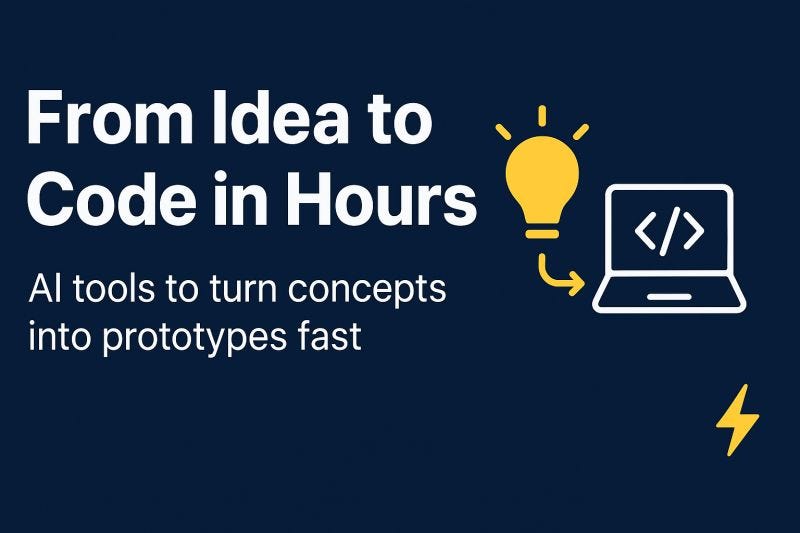From Idea to Code in Hours: AI Prototyping Tools for Product Teams
How AI‑powered prototyping transforms napkin‑sketches into working software without waiting weeks for a dev team
When good ideas collect dust
We all know the feeling: you get a burst of inspiration for an app or feature, jot some notes on a napkin and… nothing happens. Real life intrudes, the blank editor looks intimidating and the idea sits in limbo for weeks. Even product managers with dedicated engineers struggle to get prototypes built quickly enough to run timely tests.
A wave of AI prototyping tools is flipping that script. Rather than starting from an empty canvas, you describe your vision, and AI scaffolds a working version almost immediately. Lenny Rachitsky’s guide to AI prototyping notes that tools like Cursor, Replit Agent and v0.dev can convert Figma designs or plain‑language product briefs into functional apps in minutes. BuildBetter’s research shows that these tools can cut feature development timelines by two to three weeks and reduce iteration cycles by up to 50 %.
This article explores why AI prototyping is more than hype. We’ll unpack the benefits, highlight real‑world examples and share how you can harness these tools to get your ideas into users’ hands fast.
No blank page fear – AI gives you a starting point
Traditional prototyping starts with a designer or developer staring at a blank canvas. AI changes that. Tools ranging from chat‑based assistants to sophisticated design platforms can generate rough drafts from natural‑language descriptions.
Lenny’s research groups AI prototyping tools into chatbots, cloud development environments and local assistants. Chatbots like ChatGPT and Claude are best for simple prototypes and can’t host code, but they’re great for generating starting snippets or UI copy. Design platforms such as Figma’s Genius plugin or Uizard turn text prompts into wireframes and even fill in UI content. BuildBetter notes that Figma AI’s Genius plugin can translate a prompt into a complete wireframe and generates appropriate copy, saving designers hours. Uizard goes further, converting hand‑drawn sketches into interactive prototypes with features like Autodesigner and a Screenshot Scanner.
The power of these tools isn’t just speed. When the AI spits out a viable draft, you avoid analysis paralysis. There’s something tangible to critique, tweak and build upon. As one designer quoted by BuildBetter says, “AI can generate 80 % of the work so I can focus on the 20 % that requires human nuance”. With a skeleton in place, you can immediately refine flows, add branding or adjust layouts instead of labouring over initial structure.
Instant UI drafts – wireframes and code in minutes
Beyond brainstorming, AI prototyping tools now handle full‑stack infrastructure. Cloud development environments like v0.dev, Replit Agent and Bolt don’t just draw screens – they spin up real databases, back‑end endpoints and deployment pipelines. Lenny’s newsletter describes how v0 deploys both client and server code with sensible styling defaults, while Bolt runs server code directly in the browser. In other words, you can have a functional login page or dashboard running in less time than it takes to brew a coffee.
Design‑centred tools pack similar magic. Framer AI creates responsive prototypes from a single prompt, complete with transitions and interactive states. Builder.io’s overview of Figma Make shows how the tool uses AI to automatically connect screens, generate component states and create multi‑screen flows. The result: interactive prototypes in seconds instead of hours.
These environments aren’t just gimmicks. In a case study shared by ProdPad, a product manager built a draggable dashboard widget in Bolt in roughly four hours, including back‑end logic. Another company used Replit with GPT‑powered code to simulate a telehealth appointment scheduler in a single afternoon. When you can generate working UI and server code in minutes, your focus shifts from setup to user experience: what flows delight users? Which data models support them best? This is where human insight shines.
Faster testing and feedback
The magic of AI prototypes is that they aren’t just pretty pictures – they behave like real products. ProdPad’s blog emphasises that AI‑generated prototypes mimic business logic and back‑end behaviour. You can hook them up to realistic data, letting testers click through multi‑screen journeys and feel out interactions. Because there’s no engineering hand‑off, product managers can gather feedback and metrics on the same day they come up with an idea.
This speed is transformative. Early‑stage hypotheses often come with uncertainty; the only way to know whether users will value a feature is to put something in front of them. AI prototyping makes that feasible. Build multiple variants, run quick A/B tests and refine based on user reactions. As the ProdPad article argues, AI prototypes are perfect when you have high uncertainty, need to test multiple variants or when static mocks aren’t enough.
The result isn’t just faster validation – it’s motivation. When your idea goes from concept to clickable product in hours, you see tangible progress. That momentum carries into subsequent iterations and helps secure stakeholder buy‑in because there’s something concrete to show.
The human touch: co‑building with AI
A common misconception is that AI will replace designers or engineers. The research paints a different picture. AI is most powerful when it handles the repetitive scaffolding so humans can focus on nuance. BuildBetter’s survey reports that over 62 % of designers leverage AI to automate repetitive tasks while emphasising that “human insight” remains critical.
Think of AI tools as co‑pilots. They generate first drafts, spin up infrastructure and handle boilerplate. You still choose the colors, refine the copy, define the user flows and ensure that the solution aligns with your product vision. AI does not know your users’ pain points or brand voice, but it gives you a head start.
Looking ahead, the future of software development likely won’t involve writing every line by hand. Instead, we’ll co‑build with AI, iterating rapidly and focusing on creative problem solving. As Lenny’s article concludes, the value of AI prototyping isn’t just speed – it’s about staying motivated by visible progress and freeing up time for higher‑level thinking.
Takeaways
Start with a prompt, not a blank page. AI chatbots and design tools turn natural‑language descriptions into wireframes, UI copy and even back‑end code.
Speed to prototype matters. Cloud development environments like v0 and Replit build full‑stack prototypes in minutes, cutting development timelines by weeks.
Test sooner, iterate faster. AI prototypes mimic realistic logic and data interactions, enabling same‑day user testing and iterative refinement.
Keep the human in the loop. AI automates the 80 % of work that’s repetitive, leaving designers and product managers to focus on user empathy, branding and polished experiences.
If you’ve been sitting on a brilliant app idea, there’s never been a better time to build. Grab an AI prototyping tool, describe your vision and watch as your concept comes to life in hours, not weeks.




